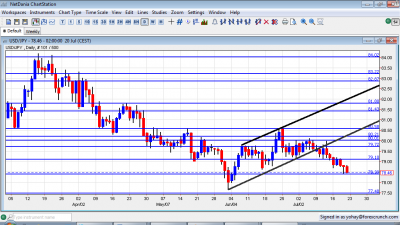USD/JPY continued the downfall, as the dollar slid against (almost) everybody Will the BOJ intervene? Masaaki Shirakawa’s speech, inflation data and retail sales are the highlights of this week. Here’s an outlook for the Japanese events and an updated technical analysis for USD/JPY.
Last week, the minutes of the Bank of Japan’s June meeting were released revealing a unanimous vote to maintain rates at 0-0.1%. Domestic economy remains sluggish and global risks still pose a threat to Japan’s recovery prospects. It was also agreed that fighting deflation is a necessary step in order to maintain a sustainable growth path.
Updates: The yen strengthened following fresh market concerns over the debt crises in Spain and Greece. USD/JPY is moving towards the 78 line, as USD/JPY was trading at 78.21. Trade Balance will be released later on Tuesday, and the markets are predicting a much lower deficit for the July reading. USD/JPY is edging lower, towards the 0.78 line. The pair was trading at 0.7816. Trade Balance hit a nine-month high and beat the market estimate, with a deficit of 0.3oT. Japan last recorded a monthly surplus last April. USD/JPY was unchanged, trading at 0.7823. CSPI dropped to a three-month low, declining by 0.3%. BOJ Governor Masaaki Shirakawa adressed a conference in Tokyo on Thursday. USD/JPY was unchanged, trading at 0.7823.
USD/JPY daily chart with support and resistance lines on it. Click to enlarge:
- Trade Balance: Tuesday, 23:50. Adjusted merchandise trade deficit climbed to Y657.2 billion in May after posting a deficit of Y512.0 in April. This was the fifteenth consecutive monthly deficit amid a 0.5% drop in exports and a 1.9% increase in imports. Since international trade is a major income source for Japan, the ongoing trade deficit weighs down on Japan’s growth prospects. A contraction to Y390 billion deficit is expected now.
- CSPI: Wednesday, 23:50. Corporate service prices in Japan went up 0.1% on a yearly base in May, reaching 96.1 after a 0.2% increase in the previous month and expectations for a 0.3% rise. The slow growth came amid a drop in advertising services and communications prices. A flat reading is predicted now.
- Masaaki Shirakawa speaks: Thursday, 0:10. BOJ Governor Masaaki Shirakawa is scheduled to speak in Tokyo at the Futures Industry Association where he is likely to explain the BOJ’s decision to maintain its monetary policy despite toe worsening conditions inJapan’s economy.
- Tokyo Core CPI: Thursday, 23:30. Core CPI for the Tokyo metropolitan area dropped 0.6% in June compared to the same month last year, following 0.8% decline in the previous month. The declines continue despite the BOJ commitment to end deflation by further monetary stimulus. The same drop of 0.6% is anticipated now.
- Retail Sales: Thursday, 23:50. Japanese retail sales increased by 3.6% in May lower than the 5.7% in posted in the previous month but better than the 3.1% rise predicted by analysts. Private consumption is the main source of comfort to Japan’s battered economy with an ongoing improvement in the automobile sector flourishing due to government subsidies on fuel-efficient cars. However this improvement is likely to stop once the subsidies expire in the summer. A 1.2% gain is predicted now.
USD/JPY Technical Analysis
$/yen made a few attempts to recapture the 79.10 line (mentioned last week). After failing to do so, it gradually fell to lower ground, closing at 78.46.
Technical lines from top to bottom
84 was the peak reached in March and remains a tough spot. 83.20 provided support when the pair traded on high ground and it then switched to resistance.
82.87 is a veteran line – that’s where the BOJ intervened for the first time back in 2010. 81.80 capped the pair in April.
81.43 is stronger after serving as resistance for a recovery attempt. 80.60 provided support for the pair around the same time, and served as a bouncing spot for the next moves. It proved its strength as resistance in June 2012, more than once.
80.20 separated ranges in May 2012 and remains another barrier after 80 on the upside. The round number of 80 is psychologically important, even though it was crossed several times in recent months. It is stronger now.
79.70 was a cap was seen in June 2012. It proved its strength as resistance once again in July 2012. 79.10 was a cushion for the pair several times in June and also back in May 2012. This role continues in July.
78.40 replaces the 78.30 line after working as significant support during July 2012. This is a key line.
77.50 was the bottom border of a range the pair had at the end of 2011. It is followed by 77, which is only minor support.
76.60 was a cushion for the pair at the beginning of the year and is rather strong. 76.26 is the next line on the downside after working as a support quite some time ago.
Uptrend Support Broken
Note that after uptrend support was broken, the pair not only moved sideways, but eventually fell lower.
I turn bullish on USD/JPY.
Despite some more weak data from the US, the “safe haven” doesn’t have too much room on the downside. The BOJ might intervene to keep the yen low. Even if such intervention isn’t successful in the long run, it may stop the bleeding.
Further reading:
- For a broad view of all the week’s major events worldwide, read the USD outlook.
- For EUR/USD, check out the Euro to Dollar forecast.
- For GBP/USD (cable), look into the British Pound forecast.
- For the Australian dollar (Aussie), check out the AUD to USD forecast.
- For the New Zealand Dollar (kiwi), read the NZD forecast.
- For USD/CAD (loonie), check out the Canadian dollar forecast
- For the Swiss Franc, see the USD/CHF forecast.
